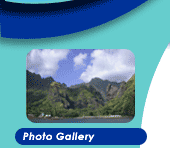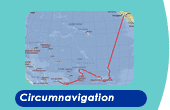September 19, 2003
13°49.583S, 167°22.994E
Waterfall Bay, Vanua Lava, The Banks Islands, Vanuatu
Touched by the Ni-Vanuatu of Waterfall Bay
By Lois Joy
Go
to photo Albums for photos for this story  
As dawn breaks over the hills of Vanua Lava and Pacific Bliss bobs
gently in the bay, I look back on the three days of The Waterfall Bay
Cultural Festival here with fond memories: the warmth and friendliness
of the villagers as they shared their customs with us; the shy smiles
of the Pikinini as they stole furtive looks at the fair-skinned yachties;
the gentle kiss placed by of one of the men on the Captain’s cheek
as we said farewell.
But it is the closing song ‘We Are Friends’, belted out
by the choir in their bright orange and yellow costumes, that will remain
etched in my mind forever. My eyes teared as one performer after the
other stepped out in front of the group on the dais to sing a poignant
solo phrase, “My name is Martha and I love you; my name is Robert
and I love you; my name is Jimmie and I love you…”
The Banks and Torres island groups form the province of Torba and are
administered from the town of Sola on Vanua Lava. These are the northernmost
and most remote of the islands of Vanuatu, consisting of 62 islands,
only 13 of which are inhabited. As is the common story in these islands,
they suffered heavily from blackbirding and disease in the later half
of the 19th century. By the 1930s there were barely 2000 people left;
now the population is recovering and stands at 8000 or so. Altogether,
these islands have four small airfields, but little in the way of accommodation
or motor transport. In fact, there are only 30 km of roads in the entire
Banks group. Gaua and Vanua Lava, the islands we have visited so far,
have only 8 km each! Needless to say, despite beauty and culture that
rivals any islands we’ve seen in the South Pacific, very few tourists
make it to this part of Vanuatu. Most of those who do are yachties.
We found out about the Cultural Festival through the tourist office
in Port Vila, the capital of Vanuatu. The program was also promoted
on the Namba Net, the cruisers’ SSB net here. (Namba, in case
you’re not familiar with the term, is a penis wrapper or sheath
made from dried banana or pandanu leaves dyed red, purple or green.
They are worn by Ni-Vanuatu males during traditional, or ‘Kastom’
ceremonies. Some men from very kastom-oriented villagers wear them all
the time.)
The three-day festival was well worth the time and effort to sail this
far north. We took our time sailing from Port Vila, stopping at villages
and anchorages along the way with Rolf and Daniella on Yelo, another
Catana 431, arriving on Sunday, September 14th, the day before the event.
Seventeen yachts were anchored in Waterfall Bay for the Festival. At
2000 vatu (about $18 US) per head, in addition to food stall and craft
sales, it was a good money-maker for the islanders and will enhance
their standard of living for the entire year. This was their very first
Festival. Based on this initial success, the organizers plan to make
it an annual event.
As we dropped and set the anchor, Kerely waited patiently by in his
dugout canoe. The festivities would celebrate his gaining the title
of chief in a grade-taking ceremony, formerly a part of the nimangki
system, called sukwe here in the Banks. Kerely—a black-bearded,
soft-spoken young man of medium build, solid and fit—welcomed
us to the Bay on behalf of the three large families who live here. There
is no village, only a compound that Kerely had built here three years
ago. Within an hour, Captain Jouke of Freya, a Dutch yacht, dinghied
over to hand us a schedule he’d printed out covering the three
days. There were no times noted, just a starting time of 0800 for each
day and a list of activities. Events would unfold, we discovered, on
“Vanuatu Time.”
The Festival began on Monday morning with a short walk along a stony
footpath to the natives’ pride and joy: a double waterfall, as
dramatic as any we’d seen in all of New Zealand. “If this
natural wonder were there, it would be fully marketed,” said Gunter
as we gazed in wonder at the dual rivers high above as they tumbled
down over giant, jutting rock formations, falling into a deep, dark
pool of water close to the sea.
“We yachties are so fortunate to be able to sail here,”
I replied. There were no tourists, no backpackers, at this wonderful
Festival. I had read the Lonely Planet’s description of how to
get here: “From Sola you can do a three day return walk around
the South Coast to Sarah Falls, overnighting at Vureas Bay where there’s
a small guesthouse by a black swimming beach. This place charges 2000VT
for a bed and all meals; you pick up a guide here for the falls. Villagers
say it’s a reasonably easy, day return walk from Vureas Bay to
the falls, where there’s no camping, so aim to spend two nights
with them. It’s a half day walk from Sola to Vureas Bay.”
In the same section of the Guide is the warning: “In 1998 none
of these places were providing mosquito nets,” this, in an area
known to have outbreaks of malaria and dengue fever.
We were escorted back to the Festival grounds by the families who live
here. Curious children stole furtive looks at the white people, and
then hid behind their mothers’ skirts when we smiled back. The
black sand grounds had been swept hard and clean. Many of the structures
had been constructed especially for the Festival: a community house,
a changing house, the speakers’ dais, and two outhouses with newly
poured concrete floors (with the requisite keyhole-shaped hole in the
center and an absence of hooks). Yachties who had arrived prior to the
festivities reported that the area had been a beehive of activity; many
of the structures were completed only days before the opening. Numerous
families had trekked over the 10-kilometer path all the way from the
villages at Vureas Bay to the south, carrying baskets of fruit, nangae
nuts-on-a-stick, drinking coconuts and many varieties of laplap to sell
in the five hastily-constructed food stalls. Other natives-to-the-south
had arrived via the local powerboat with a failing prop. They weren’t
sure whether their local “water taxi” would get them back.
The snake dancers opened each day’s events. To the beat of native
drums, Ni-Vanuatu males pranced around the grounds carrying striped
sticks with feathers attached, their faces and entire bodies painted
with black with white stripes. We had seen snake dancers from the Banks
cavorting on the cement around the pool during cocktails at the on Iririki
Resort near Port Vila. That performance paled in comparison to the real
thing!
Roger, the Head of Security, smartly dressed in camouflage fatigues,
raised the Vanuatu flag—very slowly—on a bent bamboo pole
while a group of bare-breasted women in grass skirts sweetly sang their
national anthem. Wow! Already, I suffered from sensory overload. And
the festivities had barely begun!
This dramatic kick-off to the Festival was followed by many welcome
speeches given from the speaker’s dais. Fringed grass decorations
hung down to the speakers’ eye-levels, obscuring their view, as
we’d seen at so many Pacific island events.
Then came the first step of a typical Vanuatu grade-taking event: the
pig killing ceremony. It began with the pig killing dance, the wildest
I’d witnessed in all of the Pacific Islands dancing we’d
seen in the past two years. The dancer wore a headdress consisting of
a white band into which were inserted springy sticks tipped with white
feathers. His face was blackened and he wore a long, Rasta-like fake
beard that hung below his waist. In his left hand, he held a bow—a
neon orange ball of fruit stuck to the end; in his right, the arrow
which would be aimed at the pig. Flowers and plants banded each muscular
triceps; woven grass banded his ankles. A woven pouch hung around his
waist, and below his grass skirt, his legs and feet were blackened.
Men in grass skirts drummed the tamtams while the fierce dancer stomped
and grunted and groaned.
This kastom pig-killing ceremony was probably mild compared to the
lavish ceremonies of early Vanuatan society. In the northern part of
Vanuatu, status within the clan was earned by males through the nimangki
system. The rituals and feasts where held to promote the adult male’s
rise up his village’s social ladder. Each grade meant a step closer
to achieving chiefly status. On a supernatural plane, the more grades
a man had earned, the more powerful would be his defenses against sorcery
while alive, and the more potent would be his spirit after death.
For the pig killing ceremony this day, a platform had been constructed,
with a stone altar where the pig would be killed. Soon-to-be-installed
Kerely sat calmly on a plant-decorated ‘throne’ near the
back of the platform, his cheeks marked with white stripes, red-and-white
designs painted on his chest. I could see the unsuspecting, ill-fated
pig tied to the front of the platform. A set of warriors came forth
to ‘hog-tie’ him; then his neck was shot through with an
arrow, presumably to silence him, since he never squealed. Next came
deathly blows to the head with a huge carved club. Soon, he lied still.
Following the gutting, the intestines were buried in front of the platform.
The family stood in front of the pig and the retiring chief gave a long,
fiery speech with much waving of arms in their native dialect. The speech
was followed by the placing of pig’s blood on the temples of each
member of the new blood-line, including the children. Then Chief Kerely
was installed. He gave an eloquent speech that was apparently very well
received, judging from the countenances of the assembled Ni-Vanuatu.
After lunch at the food stalls, Gunter and I wandered again to the
spectacular waterfalls. I surreptitiously photographed the profile of
a little girl in a frilly dress gazing wistfully at the village boys
at play. They had fashioned a vine to climb the boulders at the bottom
of the falls. They climbed, then dived off into the pool, swam the length
of it, and then climbed again. The girl turned and smiled shyly.
As we walked around, another girl approached me for an interview—a
school assignment. The questions were the typical where-are-you-from,
how-long-have-you-been-sailing, what-are-your-likes-dislikes-about-Vanuatu?
Soon a crowd of schoolchildren surrounded me. Although it was a week
day, they had obviously been excused from school for the Festival. The
children were obviously happy, fun loving and very curious about our
lives: how we live in America and why we would leave such a ‘rich
country’ to go sailing to see communities like theirs. Soon we
were talking off-the-record about their lives and dreams. One of the
common dreams we hear throughout the Pacific Islands is to go to America
some day.
I loved the attitude of the children and couldn’t get enough
of them—really missing my own grandchildren this far into the
cruising season. I never saw one manufactured toy in all our visits
to villages in the Banks Islands—not even a doll. Yet the younger
children managed to keep themselves occupied, using sticks to push stones
around, chasing each other, and climbing on the dugout canoes on the
beach. I never heard them whine, complain, or throw a tantrum.
Monday afternoon a kastom dance was performed by the males. All wore
grass skirts and woven armbands and anklebands. Some pounded on an assortment
of tamtams while others danced shaking bags of nuts. After that performance,
the women joined in and soon the dancers were bringing participants
from the audience. The Ni-Vanuatu laughed and cheered good naturedly
as we yachties kicked up the dust. By the time dusk fell and ‘security’
helped us launch our dinghies to go back to our yachts, we were all
thoroughly exhausted. We explained how yachties usually take a siesta
after lunch! The organizers dutifully inserted ‘rest time’
into the next two days’ events, so that we could dinghy back to
our yachts for a mid-day break.
Tuesday’s schedule again opened with a snake dance. Then a number
of kastom games were demonstrated. There were pantomines by what we
would call clowns—one called Wetamarge: the Old Man. Pantomime-style
demonstrations included sasqulosas, the activity of carrying men by
hand, eses moto, the activity of removing coconut fruit, and bibibis
mat, a demonstration of a snake family. One ‘game’ reminded
me of a colonial-U.S. Virginia Reel, but was performed by men only.
The women performed a hand clapping game, their bare breasts and grass
skirts swinging to the beat of the tamtams.
The afternoon was devoted to demonstrating the preparation of kakai
(food) and would culminate in a Melanesian Feast, during which we would
sample each of the dishes. What I found most interesting was the demonstration
of how to cook laplap, the national dish of Vanuatu. Round stones had
been heated the day before, then allowed to cool overnight, so that
they would not crack and fly apart. Even so, a few did when wood was
loaded on the stones to reheat them. In three separate preparation areas,
manioc, taro roots, and yams were peeled by the women using a shell,
then grated into a doughy paste. The paste was then kneaded by the men
who stomped the large end of clubs (the size of baseball bats) into
the dough. They then was spread the dough out like a pizza on a flat
circular piece of wood. Afterwards, the mixture was carefully lifted
and placed on taro leaves. Next, coconuts were opened and a shell used
again to scoop out the meat, which was squeezed by the women through
tightly clasped hands and fingers until juice ran out. The juice was
used to cover the paste. (Sometimes, poultry, fish or flying fox can
be added. In this case, the three varieties of laplap were vegetarian.)
Leaves from the laplap plant (similar to banana leaves) are then wrapped
around the doughy mix and tied up with strands of vine. The packages
are placed into the heated stone oven and covered with more stones.
It is a very starchy, filling dish. I preferred the yam variety and—with
all those hands touching it during preparation—was relieved that
it seemed very well cooked! We also sampled prawns cooked in an earth
oven. That was the only protein dish.
During the kakai preparation, many of the Ni-Vanuatu men were engaged
in making kava, called aelan bia (island beer) in Bislama. For awhile,
I watched them grind the yaqona root using a western-style meat grinder.
I surmised that the village’s one grinder is used exclusively
for that purpose. (This is a big step forward from kava preparation
in Tanna, one of the southernmost islands of Vanuatu. There, I understand,
kava roots are brought to the nakamal late each afternoon by prepubescent
boys. The roots are washed; then the boys prepare them by chewing them
into a mush and spitting the hard parts onto leaves.) The end process
is the same on both islands: The mush is placed into a container, water
is added, and the ingredients are stirred and worked around with the
hands. Then the mud-colored liquid is filtered through coconut fibers.
Once the liquid is ready for drinking, it is poured into a half-coconut
shell which is used for a cup. (For this reason, a draught of kava is
known as a shell.) As in Fiji, etiquette requires that each participant
drink his or her bowl of kava in a single gulp.
After the feast, we were all invited to participate, but it was not
mandatory. Having tried it once here already, and finding that it is
considerably stronger than the Fijian variety, I declined. Vanuatu has
a huge domestic demand for kava, which has made it the fastest-growing
agricultural commodity here. Drinkers in Luganville and Port Vila alone
consume over 500 tons of kava root each year. It is a rapidly growing
export—sold as an herbal remedy, a tranquilizer and a muscle relaxant.
On the third day of the Festival, the yachties were guided to the ridge
on top of Waterfall Bay, where we could see our yachts far below, comfortably
nestled in the bay. Our guides showed us the gardens that they work
way up there; no wonder the men and boys have such muscular bodies—it’s
quite the climb to go to work. I was drenched with sweat just getting
there. We were also shown some petroglyphs near the waterfall area.
Some hardy souls hiked to the top of the waterfall after this, but we
relaxed at the bottom. Then a group of women gave a water music performance.
But they only knew one basic tune/routine. (On the route to the festival,
Pacific Bliss and Yelo—along with a few other yachts—had
visited Chief Henry’s village in Lacona Bay, on the Banks island
of Gaua. There eight ladies had given a water music performance that
would knock our socks off—if we’d been wearing any. These
villagers have learned how to make a concert by scooping and splashing
waves of water in unison that defies description. One simply has to
see and hear it for oneself.)
That day we were treated to more Kastom dancing. The day was hot and
sunny however, and even the bare-breasted women were dancing lethargically.
When the time came for audience participation, very few yachties took
them up on their offer to join in. Then the mood picked up: Prior to
the closing ceremonies, a choir composed of young men and women who
had been trained at the mission took to the dais. They sang uplifting
Sunday School songs and spirituals that gave us all a second wind. After
the closing speeches, the choir sang three songs especially composed
for the event. Following “We are Friends and I Love You,”
they enacted two dramatic and melodious songs about Waterfall Bay, their
very special place—and now ours as well.
Waterfall Bay tugs at my heartstrings as we haul anchor. But Pacific
Bliss is destined to move on to new adventures. Today, we are setting
sail northwest for Ureparapara, formed by the tip of an extinct volcano
whose crater has been breached, forming a 3 km harbor called Lorup Bay.
It will be the northernmost island of Vanuatu that we plan to visit.
Then we will wend our way down through the island chain back to Luganville,
where we will participate in the 1000-mile Port2Port Rally to Bundaberg,
Australia.
Go
to photo Albums for photos for this story
journa108.html
|











